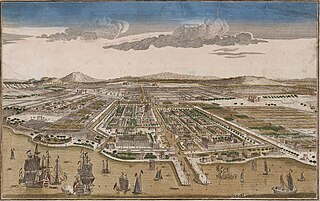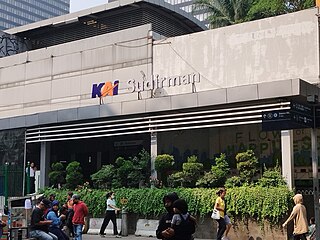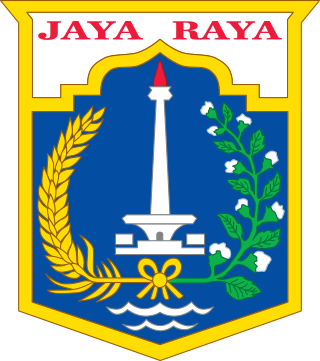
The Jakarta metropolitan area or Greater Jakarta, known locally as Jabodetabekpunjur is the most populous megapolitan area in Indonesia. It includes the national capital as well as five satellite cities and three complete regencies. The original term "Jabotabek" dated from the late 1970s and was revised to "Jabodetabek" in 1999 when "De" was inserted into the name following its formation. The term "Jabodetabekjur" or "Jabodetabekpunjur" was legalised on the Presidential Regulation Number 54 of 2008, and then the name "Jabodetabekpunjur" is officially used.

A suicide bomber detonated a car bomb outside the lobby of the JW Marriott Jakarta hotel on 5 August 2003, killing 12 people and injuring 150. Those killed included 11 Indonesians and one Dutch national. The hotel was viewed as a Western symbol, and had been used by the United States embassy for various events. The hotel was closed for five weeks and reopened to the public on 8 September 2003.

Noordin Mohammad Top was a Malaysian Muslim extremist. He was also referred to as Noordin, Din Moch Top, Muh Top, Top M or Mat Top. Until his death, he was Indonesia's most wanted Islamist militant.

Jakarta is Indonesia's capital and largest city. Located on an estuary of the Ciliwung River, on the northwestern part of Java, the area has long sustained human settlement. Historical evidence from Jakarta dates back to the 4th century CE, when it was a Hindu settlement and port. The city has been sequentially claimed by the Indianized kingdom of Tarumanegara, the Hindu Kingdom of Sunda, the Muslim Sultanate of Banten, and by Dutch, Japanese and Indonesian administrations. The Dutch East Indies built up the area before it was taken during World War II by the Empire of Japan and finally became independent as part of Indonesia.

A series of bombings took place in Jakarta, Indonesia, on 17 July 2009. At around 07:47 until 07:57 WIB, the JW Marriott and Ritz-Carlton Hotels in Setiabudi, South Jakarta, were hit by two suicide bombers. The attacks were carried out five minutes apart. Seven people were killed, including three Australians, two Dutches, an Indonesian and a New Zealander. More than 50 people were injured in the blasts. Both blasts were caused by suicide bombers, who checked into the hotels as paying guests several days earlier. The twin suicide bombings came four years after the previous serious terrorist attack in Indonesia.

The JW Marriott Hotel Jakarta is a 5 star luxury hotel in Mega Kuningan, South Jakarta, Indonesia. The hotel is adjacent to the sister Ritz-Carlton Jakarta Hotel. The hotel, operated by JW Marriott, was opened in 2001 and offers 333 rooms and suites. It has been bombed twice, first on 5 August 2003 and the second time on 17 July 2009 by terrorists. The hotel has sustained $500 million in damage from its two deadly bombings. There are now five layers of blast walls surrounding the hotel, armed security personnel, and magnetometers to enter the hotel.

Jalan M.H. Thamrin or Jalan Thamrin is a major thoroughfare in Jakarta, Indonesia. The road is located at the center of Jakarta, running from the north end of Jalan Jenderal Sudirman at West Flood Canal at the south end to the roundabout near Arjuna Wijaya Statue Jakarta at the north end. Developed in the 1950s, the road was a landmark of post-colonial Indonesia and continues to have a prominent importance in Jakarta.

Jalan H.R. Rasuna Said or Jalan Rasuna Said is one of the main avenues of Jakarta, Indonesia. It was constructed during the 1970s. It is located in the Golden Triangle of Jakarta. The road was named after Hajjah Rangkayo Rasuna Said, a National Hero of Indonesia. The road runs 4.9 km (3.0 mi) from Setiabudi, South Jakarta, to Tendean, Mampang Prapatan, South Jakarta. The Rasuna Said Street is also one of the Odd–even Traffic Restriction Scheme implementation zones.

Mega Kuningan is a business district with an integrated mixed use development concept, located at Setiabudi sub-district in Jakarta, Indonesia. The CBD is surrounded by some of the main roads in Jakarta, and is located within the Golden Triangle of Jakarta.

Sudirman Station is a train station of KRL Commuterline, which is located in Menteng, Central Jakarta, Indonesia. The station is named from Jalan Jenderal Sudirman, one of the main avenue in Jakarta, which crosses above the station. This station is located on the north bank of West Flood Canal. Though this station serves only Commuterline trains, but it is a transit point for other types of public transportation as part of the Dukuh Atas TOD.

Jalan Jenderal Sudirman or Jalan Sudirman is a major thoroughfare in Jakarta, Indonesia. Named after Indonesian national hero Sudirman, the road runs from Patung Pemuda Membangun at the south end to the bridge of the West Flood Canal to the north, where it meets Jalan M.H. Thamrin. The road had been built between 1949 and 1953 to connect Central Jakarta with Kebayoran Baru.

Sudirman Central Business District, abbreviated and locally known as SCBD, is a business district with an integrated mixed-use development concept, located in Sudirman Avenue, South Jakarta, Indonesia, with many skyscrapers consisting of condominiums, office buildings, hotels, shopping and entertainment centers. The area is considered to be the epicentrum of business in the country, with office spaces inhabited by multinational companies.

Jalan Jenderal Gatot Subroto(Gatot Subroto Avenue) is one of the major roads in Jakarta, Indonesia. The road starts from Dirgantara statue in South Jakarta, which crosses 10 administrative villages and ends at Slipi, Central Jakarta. The road is named after National Hero of Indonesia General Gatot Subroto. The road was constructed in 1960s. The road runs parallel with Jakarta Inner Ring Road. The location of the road is within the Golden Triangle CBD of Jakarta. Many important office buildings and skyscrapers are situated along the road.
Jalan Prof. Dr. Satrio or Jalan Satrio is one of main streets of Jakarta, Indonesia. The road has many important commercial buildings and shopping centers. It is named after former Minister for Health of Indonesia, Major General (Ret.) Prof. Dr. Satrio. This is a 2.25 km long road that extends from Karet Sudirman, Tanah Abang, Central Jakarta to Casablanca Tunnel, Kuningan, South Jakarta. The road is located within the Golden Triangle of Jakarta. The road crosses 4 urban villages and has access point for Mega Kuninngan.
The Golden Triangle of Jakarta, also referred to as the Medan Merdeka–Thamrin–Sudirman Axis or the Sudirman–Thamrin–Kuningan Axis, is a roughly triangular area in the center of Jakarta, Indonesia, extending from Central Jakarta to South Jakarta. Most of the city's tallest skyscrapers, office buildings and foreign embassies are located in the area. It is the main CBD of Jakarta.

The following outline is provided as an overview of and topical guide to Jakarta:

Dukuh Atas TOD is a transit-oriented development area between Central Jakarta and South Jakarta, Indonesia. This is built as part of constructing several other transit oriented development across Jakarta to facilitate commuters to transfer between different mode of public transportation.

Bendungan Hilir Station is a rapid transit station on the North-South Line of the Jakarta MRT. It is located at Jalan Jenderal Sudirman, at the border between Karet Tengsin, Tanah Abang in Central Jakarta and Karet Semanggi, Setiabudi in South Jakarta, and has the station code BNH. The station has only two railway lines separated by an island platform in the middle. Although named Bendungan Hilir, the station is not located in the Bendungan Hilir neighborhood, but rather in the east of the neighborhood.
Setiabudi 13 Case is a cold case of unsolved murder of an unidentified mutilated man found on 23 November 1981 on the sidewalk of Jalan Jenderal Sudirman, Setiabudi, South Jakarta. Due to the extreme violence and uncertainty of the case, this case is considered as the first mutilation case in modern Indonesian crime history, one of the most gruesome, and one of the most mysterious cases in Indonesia. The case is called "Setiabudi 13" since the mutilated body was found in 13 pieces and was found in Setiabudi district, South Jakarta.



















